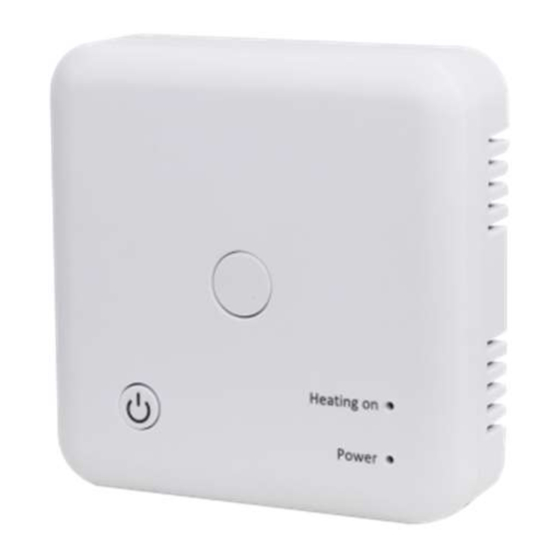
Table of Contents
Advertisement
Quick Links
This surface-mounted radio thermostat has been developed to be able to switch electric and
conventional heating systems on and off using a set temperature and time from anytime anywhere.
Functions
WiFi remote control
Large display can be clearly read with the background lighting.
Easy to fit thermostat and receiver.
Knob button make it easy to use.
4 periods of each day programmable
Child lock
Open window detection
The display shows the set temperature as well as the measured temperature, time.
Temperature display in degrees Celsius.
The thermostat is supplied with a wall-fixing frame, base and a very compact receiver
(surface-mounted).
Technical Data
Thermostat operating voltage:
Backup storage:
Receiver operating voltage:
Maximum voltage / (ohmic) load:
Frequency:
Channel selection:
Switching options:
Receiver switch contacts:
Temperature settings:
Accuracy:
Thermostat dimensions:
Receiver dimensions:
Color:
IP protection rating:
Smart Wireless Digital Room Thermostat
2*AAA battery power supply
EEPROM
230 VAC, 50/60 Hz
250 VAC/10 A.
868 MHz
By programming the thermostat and the receiver.
7 days, 4 periods each day.
NO and NC.
5°C ~ 35°C, 0.5°C increments.
+/- 0.5°C
Surface mounted, 98*98*27MM
Surface mounted, 86* 86*26 mm
White
20.
1
Advertisement
Table of Contents

Subscribe to Our Youtube Channel
Summary of Contents for Habitat WT25
- Page 1 Smart Wireless Digital Room Thermostat This surface-mounted radio thermostat has been developed to be able to switch electric and conventional heating systems on and off using a set temperature and time from anytime anywhere. Functions WiFi remote control Large display can be clearly read with the background lighting. ...
-
Page 2: Code Pairing
Smart Wireless Digital Room Thermostat Certification: CE, Rohs, RED Display PRG mode Signal icon Weekday Clock Heating working Icon Open window mode Child Lock Absence Mode Code Pairing Code pairing button Heating on indicator (LED 1) Power supply indicator (LED 2) I.Normally thermostat and receiver are paired at factory, if not this case, you can follow below step to pair. -
Page 3: Clock Adjustment
Smart Wireless Digital Room Thermostat WIFI connection with App Please download “Smart life” APP from Google play or app store. Once download, the app will ask you to register your device. Enter your email, select the country you live in and create a password for your Smart life account. -
Page 4: Mode Select
Smart Wireless Digital Room Thermostat Mode Select Press M button to select Manual Mode , Absence Mode or PRG mode Press P button to switch Manual Mode or PRG mode Clock Adjustment Press and hold M button for 3s, set the clock by adjusting the knob to left or right, each press of M button will go to next item setting. -
Page 5: Child Lock
Smart Wireless Digital Room Thermostat Switching Differential This function allows you to increase the switching differential of the thermostat (refer to the menu 09 of parameter settings). The default is 0°C which means that with a set temperature of 20°C, the thermostat will switch the heating on at 19.5°C and off at 20.5°C. -
Page 6: Wiring Diagram
Smart Wireless Digital Room Thermostat Factory reset 1: Yes, and then press On/off button for 5s,wait until thermostat restart Software Number 32dE Version Number 0110 Battery Power indication Read Only Wiring Diagram Installation Mount the thermostat at eye level. Read the instructions fully so you get the best from our product. - Page 7 Smart Wireless Digital Room Thermostat Installation Receiver: 1. Using a small screw driver, slightly loosen the screw located at the base of the RF-Switch. You can then carefully separate the front panel from the back plate. 2. Position the RF-Switch back plate on the wall, fixing into place using the screws provided. 3.



Need help?
Do you have a question about the WT25 and is the answer not in the manual?
Questions and answers